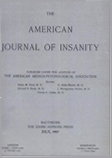POST PROHIBITION ALCOHOLIC PSYCHOSES IN NEW YORK STATE
Abstract
A marked decline in first admissions of alcoholic psychoses to the New York State hospitals has taken place during the past two decades.
The lowest admission rate occurred in the fiscal year ending June 30, 1920, viz., 1.9 per cent.
Since 1920 there has been a gradual rise in admissions, the peak of the curve being reached in 1927, viz., 7.0 per cent. In 1928 the rate dropped to 5.9 per cent.
The reduction in the admission rate has been relatively greater among women than among men.
First admissions with alcoholic psychoses come principally from urban districts.
The rate of admissions with alcoholic psychoses is greater among the foreign born than among the native white born.
The two races in which alcoholic psychoses are most prevalent are the Irish and the Slavonic races.
The rate is relatively higher among Negroes than among the native white population.
Alcoholic psychoses among the Hebrew race is comparatively rare.
Alcoholic psychoses, as a rule, occur principally in middle age, following years of intemperate use of alcohol. The acute phase generally develops in connection with recent excesses.
There has been a general reduction in the intemperate use of alcohol among all first admissions to the New York State hospitals from 1911 to 1927.
Acute hallucinosis is the outstanding type of alcoholic psychosis admitted to the Binghamton State Hospital.
There has been observed a change in the symptomatic picture as compared with the pre-war type, in that the patients appear more toxic and prostrated. There is often confusion, disorientation, combined hallucinations and delirious admixtures during the acute phase.
Recovery in the more severe cases is slower than in pre-war days. Korsakow’s psychosis has decreased in frequency since the war, and the mental symptoms and polyneuritis are much less severe than formerly. Permanent mental and physical residuals are less common, and recoveries are more frequent than in the pre-war period.
Access content
To read the fulltext, please use one of the options below to sign in or purchase access.- Personal login
- Institutional Login
- Sign in via OpenAthens
- Register for access
-
Please login/register if you wish to pair your device and check access availability.
Not a subscriber?
PsychiatryOnline subscription options offer access to the DSM-5 library, books, journals, CME, and patient resources. This all-in-one virtual library provides psychiatrists and mental health professionals with key resources for diagnosis, treatment, research, and professional development.
Need more help? PsychiatryOnline Customer Service may be reached by emailing [email protected] or by calling 800-368-5777 (in the U.S.) or 703-907-7322 (outside the U.S.).



